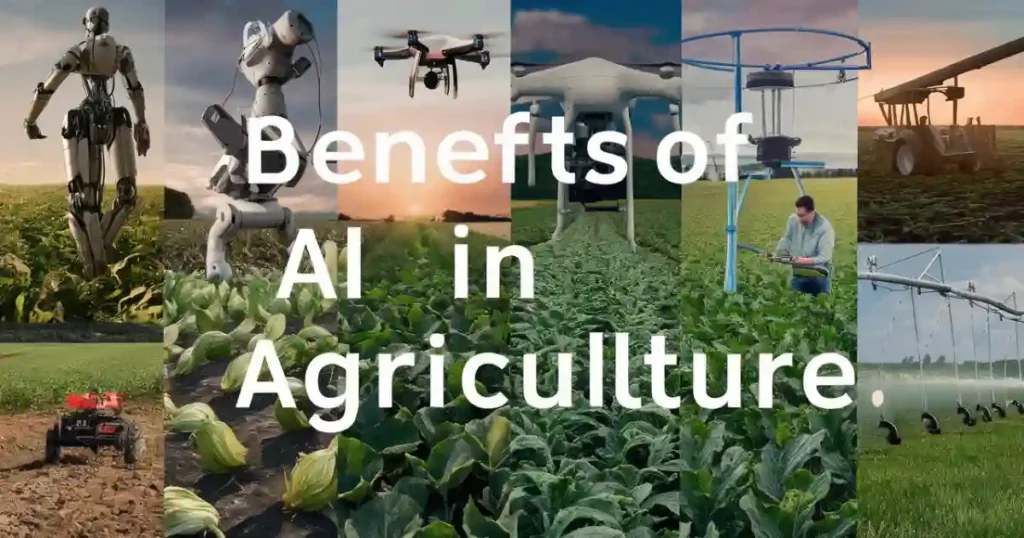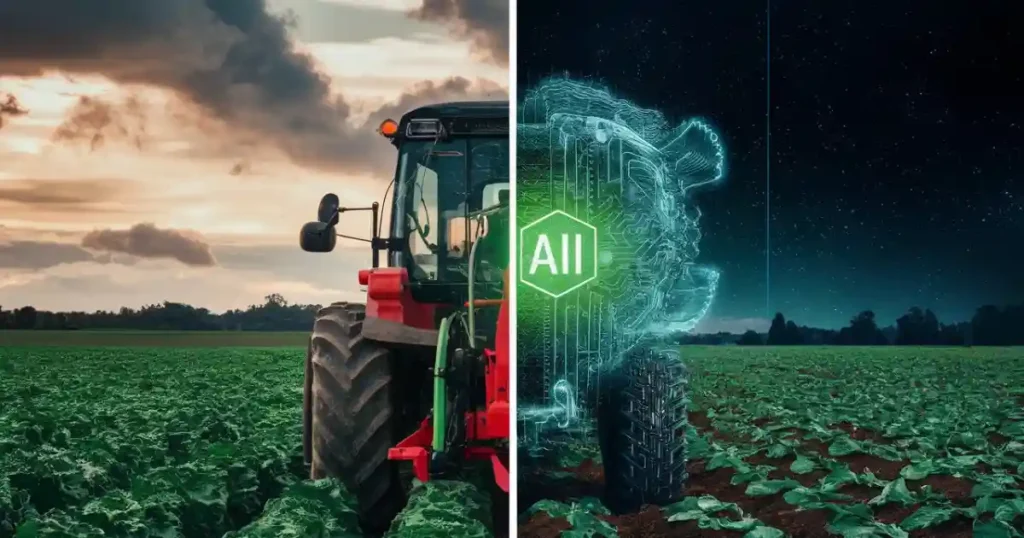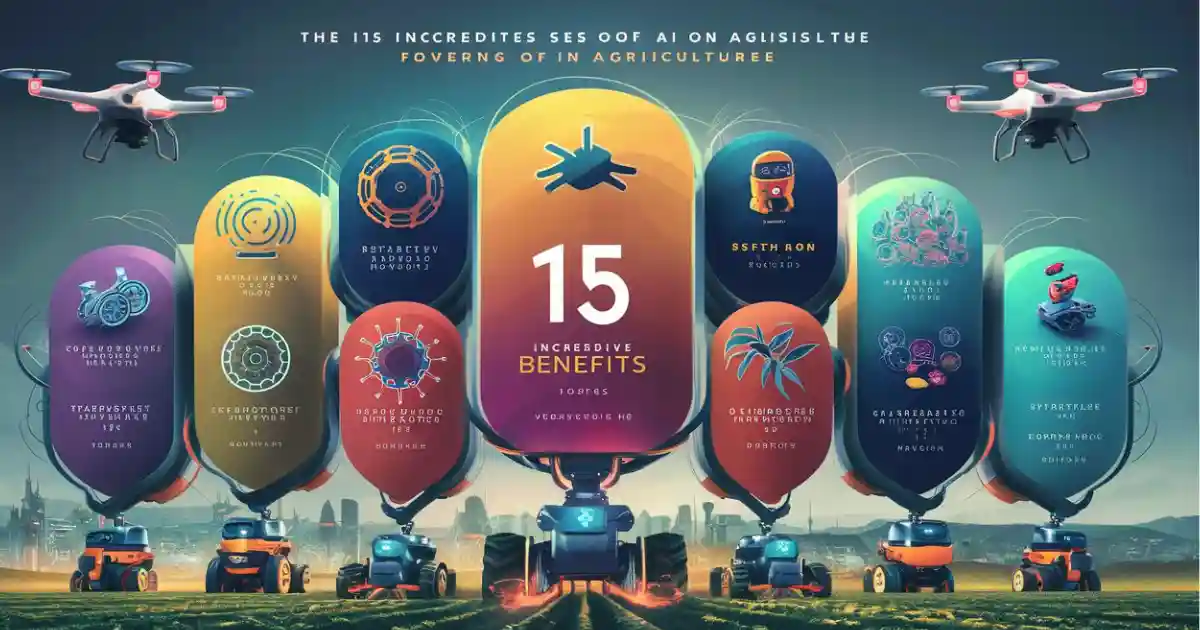By 2024, the agricultural world will produce about 4.5 petabytes of data daily. Yes, that’s a lot. It’s like 4.5 million gigabytes or over a billion smartphone photos. This huge amount of data will change farming with the help of artificial intelligence (AI).
AI, through machine learning and data analysis, is changing the way we farm. It looks at loads of data to do things like boost crop output, better manage resources, and make farming more eco-friendly.
This article dives into how AI will bring 15 big benefits to farming. This includes more crops, less pesticide, smarter water use, and much more. Let’s see how AI is making farming smarter, greener, and more efficient.
Table of Contents
Key Takeaways:
- AI is changing how farms run and make decisions.
- By using a ton of data, AI makes crops better, saves resources, and operates more smoothly.
- AI helps in deciding smartly using predictions and automation. This makes resource use better and helps the planet.
- Using AI, farms can watch how plants are doing, save water, and use resources wisely.
- Big names like John Deere and Climate Corporation are using AI in farming and showing its benefits.
Efficiency and Sustainability in Agriculture
Efficiency and sustainability are key in agriculture today. We must meet the rising global food need while protecting our planet. Artificial intelligence (AI) is changing farming. It brings insightful data, precise farming methods, and predictions using data analysis.
AI is helping agriculture in many ways. It boosts crop yields and cuts down on pesticides. It also helps use water better and requires fewer people to work. It’s crucial for food safety and less food waste. Plus, it helps create new plant types.
An important part of AI in farming is how it uses resources better. By analyzing data, it tells farmers the best amounts of water, fertilizers, and more for each crop. This leads to using water better. It also means we don’t use too many resources, making farming more sustainable.
AI can also help small farmers reach bigger markets. It gives them up-to-date data and advice through real-time information. This helps them make smart choices. They can improve their crop growth and find new places to sell their goods.
Farm automation with AI also means fewer worker costs. Robots and drones can do tasks like planting or watching crops. They do this work well and fast. This means farmers don’t need as many people to do the job.
“AI revolutionizes agriculture by optimizing resource allocation, reducing waste, and promoting sustainable practices.”
AI is great at keeping food safe. It looks out for diseases or pests early on. By watching crops all the time, it spots problems fast. This lets farmers deal with issues right away and keeps our food safe.
AI is also tackling food waste. It figures out how long foods will stay good. By looking at how they’re handled, AI helps make sure food doesn’t get wasted. This is good for the environment and saves money too.
To sum up, AI has made farming better in many ways. It has upped crop yields and cut down on pesticides. It’s improved water use, saved on worker costs, and made food safer. Less food is wasted. New plant types are being made. And farming is becoming more sustainable. Small farmers are finding it easier to sell their goods. These changes are helping us farm in ways that are good for the earth.
Case Study: Increased Crop Yields through AI
Monsanto’s use of AI shows how it can raise crop yields. They use tech like machine learning and computer vision. This lets farmers check on crop health, growth, and nutrients in real time. This early check helps farmers make sure their crops grow as much as possible.
| Benefits of AI in Agriculture | Examples |
|---|---|
| Increased crop yields | Monsanto’s field monitoring solution |
| Reduced pesticide use | Corteva Agriscience’s predictive analytics for pest management |
| Improved water management | SWIIM System’s smart water management platform |
| Reduced labor costs | Harvest Automation’s robotic solutions for labor-intensive tasks |
| Improved food safety | IBM Food Trust’s blockchain technology for traceability |
| Reduced food waste | Apeel Sciences’ plant-based coating to prolong shelf life |
| Development of new crop varieties | Benson Hill’s CropOS platform for crop breeding |
| Improved sustainability | Agrible’s sustainability analytics and insights |
| Better market access for small farmers | Farmers Business Network’s digital marketplace |
Current Challenges in Agriculture
The agriculture sector faces several big challenges. These affect how well it works, makes money, and helps the planet. Some of these problems are not enough workers, rising costs, harm to the environment, and the need for new technology.
Labor Shortages
There’s not enough workers, which is a big issue. More people means more food is needed. But, it’s hard to find skilled people to work the land. When there’s not enough help, farms can’t produce as much. This can lead to food going to waste.
Rising Costs
Running a farm is getting more expensive. Prices for fuel, fertilizers, and pesticides keep changing. Also, farms need more modern machines. All these things make it hard for farmers to make a profit. This is especially true for those with small farms.
Environmental Impact
Traditional farming can harm the environment a lot. Using too many chemicals hurts the soil and water. It can also damage the places where animals live. Cutting down trees and not using water wisely takes a toll on nature. This is why it’s vital to find ways to farm that treat the earth better.
Need for Technological Advancements
Farming needs more tech to solve its problems. Things like AI, robots, and smart farming can help. They make farming more efficient, boost production, and cause less harm to the planet. By using these tools, farmers can farm smarter and in a way that’s better for everyone.
We must find new ways to fix agriculture’s problems. By combining old and new methods, we can have farms that work better. They’ll produce more without hurting the environment. This way, the future of farming looks bright and strong.
Practical Applications of AI in Agriculture
AI is transforming agriculture by improving farming methods and sustainability. It does this by using precision farming, crop monitoring, and smart irrigation systems. These AI tools are changing the way farmers work across the world.
Precision Farming
Precision farming helps farmers get the most from their crops. It uses drones and satellites to watch crops in real time. This way, farmers can quickly address any issues to keep their crops healthy and to improve their harvest.
Crop Monitoring
AI systems for crop monitoring are key for farmers. They use sensors to keep an eye on the crops. This helps in spotting problems early, such as pests or illnesses. Farmers can then act fast to protect their crops, which helps them avoid losing too much of their harvest.
Predictive Analytics
Predictive analytics help farmers plan ahead with the help of AI. By looking at past weather, these tools suggest the best times to plant and how to use water and fertilizers. This smart approach helps in managing resources better, reducing risks, and improving how farms are run.
Smart Irrigation Systems
Smart irrigation systems are a big leap in water management for farms. They use soil sensors and upcoming weather to decide when and how much to water crops. As a result, these systems avoid waste, saving water and ensuring crops grow efficiently.
Resource Management
AI in farming also helps in managing resources wisely. It offers advice on how to use land, water, and energy more efficiently. These AI suggestions are based on detailed data, aiming to increase farm output while reducing waste and harm to the environment.
| Precision Farming | Crop Monitoring | Predictive Analytics | Smart Irrigation Systems | Resource Management |
|---|---|---|---|---|
| Real-time monitoring of crop health, growth patterns, and nutrient levels | Early detection of pests, diseases, and nutrient deficiencies | Optimization of planting schedules, irrigation practices, and fertilizer applications | Efficient utilization of water resources through real-time monitoring and weather forecasting | Optimization of resource allocation for sustainable farming practices |
| Maximization of crop yields | Minimization of yield losses | Improved decision-making for enhanced productivity | Conservation of water resources and reduction of wastage | Minimization of waste and environmental impact |

Benefits of AI in Agriculture
Integrating artificial intelligence (AI) in agriculture has many advantages. It helps farmers make the most of their resources. They can improve how they make decisions and work more efficiently. This also lessens the harm on the environment.
Increased Crop Yields
AI in farming boosts crop production. It uses tech like real-time monitoring to watch over plants. This tech can spot problems early and fix them fast. By using data about crops and the land, farmers can grow more food. They also grow stronger and healthier crops.
Reduced Resource Wastage
AI helps cut back on wasting water, fertilizers, and chemicals. It does this by carefully tracking the farm’s needs. With AI’s guidance, farmers spread these resources only where they’re truly needed. This smart use prevents waste. It also saves the earth’s resources, making farming more sustainable.
Improved Decision-Making
AI gives farmers better tools to make choices. It looks at a lot of data to help predict outcomes. This can help with planting times, watering needs, or how to handle pests. These insights from AI make farming smarter and more productive.
Operational Efficiency
AI makes farms work better and faster. It reduces the amount of work farmers need to do by hand. Machines and robots can now plant, harvest, and check crops. This boosts how much gets done. It also lowers the cost of needing lots of workers.
Reduced Environmental Impact
AI can be a big helper in taking care of the planet. It makes sure farming chemicals and water are used just right. This helps cut down on pollution and waste. With AI, farming can help to keep the environment safe and healthy for the future.
| Benefit | Description |
|---|---|
| Increased Crop Yields | AI enables real-time monitoring and data analytics to optimize growing conditions, leading to higher crop yields. |
| Reduced Resource Wastage | Precision farming techniques driven by AI minimize resource wastage, conserving water, fertilizers, and pesticides. |
| Improved Decision-Making | AI-generated insights and predictive analytics assist farmers in making informed choices for enhanced productivity. |
| Operational Efficiency | Automation and AI-driven technologies streamline farming processes, increasing productivity and reducing labor costs. |
| Reduced Environmental Impact | Precision farming techniques enabled by AI minimize chemical use and water consumption, promoting sustainability. |
Case Studies and Examples
Several companies are using AI in agriculture. A standout is John Deere. They have AI in their machines to aid in precision agriculture. This helps farmers by making their decisions more data-based and boosting their field productivity.
Climate Corporation is another key player. They provide smart farming solutions that look at field data to give insights on crop health. Their use of AI helps farmers use resources better, making farming more efficient and eco-friendly.
Then, we have Blue River Technology. They are making a mark with their robotic weeding tech. This AI and computer vision-based system does accurate weed control without much herbicide. It cuts costs for farmers, lowers environmental harm, and boosts crop health and quality.
“John Deere’s use of AI in precision agriculture, Climate Corporation’s data-driven farming solutions, and Blue River Technology’s robotic weeding systems are prime examples of how AI is transforming the agricultural industry and driving innovation in farming practices.”
Challenges and Opportunities in Implementing AI in Agriculture
Implementing AI in agriculture faces some hurdles but also opens big doors. One big challenge is keeping farmers’ data safe. This data is valuable and should be used with care to avoid misuse. We need strong rules and ways to protect this data for the good use of AI in farming.
Small-scale farmers find it hard to start with AI. They may not have the skills or enough money for the tech. To help, we must create AI solutions that fit their needs and budget. This way, every farmer can benefit from AI, no matter the size of their farm.
The use of AI in farming brings many chances for growth and protecting our planet. AI can help farmers grow more crops with less waste. It also makes farming smarter, helping farmers make better decisions and even save the environment.
Training Programs: Empowering Farmers with AI Skills
Farmers need to learn about AI to fully use its benefits. We should set up programs to teach them. These programs would not just talk but also show how AI can improve their farming. With the right knowledge, farmers can make the most out of AI.
Opportunities for Rural Development and Sustainability
AI offers a bright future for farming, improving not just profits but also the planet. By using AI, farmers can grow more food without wasting resources. It also makes farming “smarter,” using technology to benefit both farmers and nature. This change can lead to lasting development in rural areas.
“Implementing AI in agriculture is not without challenges, but the rewards are immense. By addressing privacy concerns, breaking barriers for small-scale farmers, and providing training programs, we can unlock the full potential of AI for rural development, sustainability, and the future of agriculture.”
| Challenges in Implementing AI in Agriculture | Opportunities in Implementing AI in Agriculture |
|---|---|
| Data privacy and security concerns | Enhanced crop yield and profitability |
| Barriers for small-scale farmers | Reduced resource wastage |
| Need for training programs | Improved decision-making and operational efficiency |
| – | Reduced environmental impact |
| – | – |

Future Prospects and Recommendations
The future for agriculture using AI is bright. AI tools can make farming better and more sustainable. Several steps can help farmers use AI well.
1. Adoption of AI Training Programs
Teaching farmers about AI is vital. These training programs should show them how AI can improve their farms. This will help them grow and work more efficiently.
2. Infrastructure Investments
Good internet and data storage are essential for AI in farming. They make connecting and analyzing data easier. Governments and groups need to improve these things so farmers can use AI well.
3. Continued Investment in Research and Development
Pushing AI research helps agriculture. New AI models and solutions can solve farming problems. Partnering between researchers and farm tech companies leads to better AI for farms.
4. Collaboration between Stakeholders
Teamwork is crucial for AI in farming to work. All kinds of experts need to come together to share knowledge. This helps find solutions for better and sustainable farming with AI.
Implementing these suggestions can transform farming with AI. It will increase efficiency and advance sustainable agriculture.
Conclusion
Artificial intelligence (AI) is changing agriculture in exciting ways. It’s making farming better, smarter, and more earth-friendly. The use of AI means bigger harvests, less harm to the planet, and operations that run more smoothly.
As AI grows, so do the chances for the farming world. It gives farmers new ways to use data to farm better, saving on resources and keeping crops healthy. Using AI also means working in a way that doesn’t use up the environment.
Agriculture’s future looks brighter with AI. It helps farmers grow more food efficiently, use up less, and decide smarter. This way, we all work towards farming that’s not just better, but also kinder to our world.
FAQ
What are the benefits of AI in agriculture?
AI in agriculture boosts crop yields and cuts resource use. It makes decisions smarter and operations more efficient. It’s also good for the planet by reducing environmental harm and saving resources.
What challenges does the agriculture sector face?
The sector deals with fewer people wanting to work, higher costs, and its effect on the environment. It also needs to keep up with new technologies.
How is AI applied in agriculture?
Precision farming and monitoring technologies are a big part of AI in farming. It also uses predictive analytics and smart systems for irrigation and managing resources.
How does AI benefit agriculture?
AI helps agriculture by boosting yields and cutting down on waste. It makes decisions sharper and operations smoother. Plus, it encourages sustainability and green farming practices.
Can you provide examples of AI being used in agriculture?
Yes, there are many examples of AI in action in farming. John Deere uses AI in its machines for precise farming. Climate Corporation provides farming tech based on data. And Blue River Tech makes AI-driven robots for weeding.
What are the challenges and opportunities in implementing AI in agriculture?
Putting AI in farming faces issues like data safety, particularly for smaller farmers. Yet, it opens paths for rural growth and ways to farm that are gentle on the earth.
What is the future of agriculture with AI?
The future pairs AI heavily with all parts of farming. More research, teamwork, and embracing eco-friendly methods are vital. This will fully unlock AI’s benefits in farming.





